Introduction
In the realm of IT service management, Service Level Agreements (SLAs) emerge as pivotal instruments that define the expectations and responsibilities between service providers and their clients. These formal documents not only set forth specific performance metrics but also cultivate a culture of accountability and transparency essential for successful service delivery.
As organizations increasingly prioritize reliability and customer satisfaction, understanding the nuances of SLAs becomes imperative. From delineating key components and best practices to exploring the advantages and challenges associated with their implementation, this article delves into the multifaceted nature of SLAs.
It further examines emerging trends and innovations that are shaping the future of these agreements, ensuring they remain relevant in an ever-evolving technological landscape. Through this exploration, stakeholders can enhance their approach to SLA management, ultimately driving improved service quality and fostering stronger business relationships.
What is a Service Level Agreement (SLA) and Why is it Important?
A Service Level Agreement (SLA) is an essential formal document that outlines the anticipated level of support from a provider. It delineates specific performance metrics, including availability and response times, while clarifying the responsibilities of both parties involved. By establishing these clear expectations, the advantages of service level agreement (SLA) play an indispensable role in fostering accountability and transparency within partnership relationships.
As the demand for high availability rises, particularly in high-frequency trading and high-performance computing sectors, a target of 99.999% availability is increasingly recommended. This precision in expectations contributes significantly to mitigating risks, as both providers and clients gain a mutual understanding of their obligations. This alignment not only results in improved delivery but also enhances customer satisfaction by ensuring offerings meet predefined standards.
In the present competitive environment, where trust and reliability are crucial, the advantages of service level agreement act as vital instruments for efficiently managing relationships and aligning business goals with the provision of services. Furthermore, the advantages of service level agreements are foundational to the successful implementation and management of cloud offerings, promoting trust, transparency, and accountability between providers and clients. Furthermore, agreements provide frameworks for dispute mediation and outline exit strategies, including data migration and termination processes, which help manage conflicts and ensure a smooth transition when concluding contracts.
As noted in a recent industry report,
AI-driven tools provide the precision, scalability, and adaptability required for effective SLA management in dynamic environments.
This emphasizes the evolving nature of SLAs, highlighting the advantages of service level agreement as they adjust to contemporary technological demands, reinforcing their significance in IT management. Furthermore, identifying cost-effective cloud storage providers is essential for IT System Operations professionals, as it directly impacts their ability to meet SLA commitments.
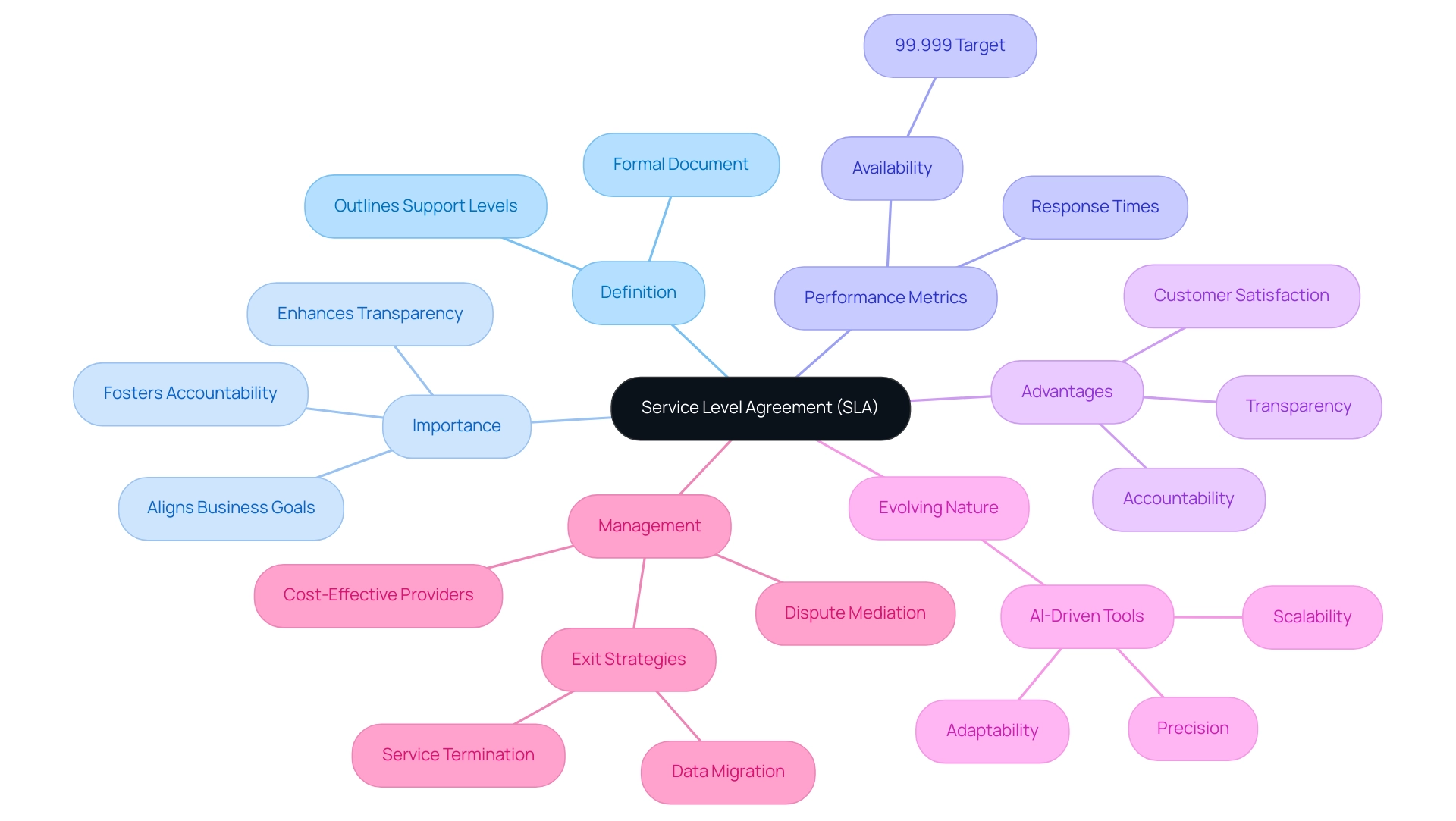
Key Components and Best Practices for Effective SLAs
The advantages of service level agreement are evident in a successful SLA, which includes several essential elements:
- Comprehensive descriptions of offerings
- Specific effectiveness metrics
- Organized reporting protocols
- Explicitly outlined penalties for non-compliance
The advantages of service level agreements include financial penalties and service credits that act as motivators for service providers to achieve agreed-upon service levels, ensuring accountability and effectiveness. To optimize the advantages of service level agreement creation process, best practices recommend involving all relevant stakeholders to ensure that diverse needs are addressed.
Establishing realistic and measurable objectives is crucial, as it facilitates accountability and clarity, highlighting the advantages of a service level agreement. Moreover, regular reviews and updates of the SLA are necessary to highlight the advantages of service level agreement in adapting to evolving business requirements and technological advancements. Clear communication regarding the advantages of service level agreement's terms and conditions is vital to prevent misunderstandings and uphold accountability.
Notably, focusing on the eight key SLA metrics can significantly enhance IT team performance, leading to better decision-making in data-driven organizations by ensuring high data quality and reducing errors. This is especially clear in the case study titled "Understanding Risks in Cloud Computing Agreements," which demonstrates the importance of examining agreements to identify major risks that may impact delivery. As emphasized by industry specialist Camilo Quiroz-Vazquez, greater transparency in agreements promotes trust and efficiency in management.
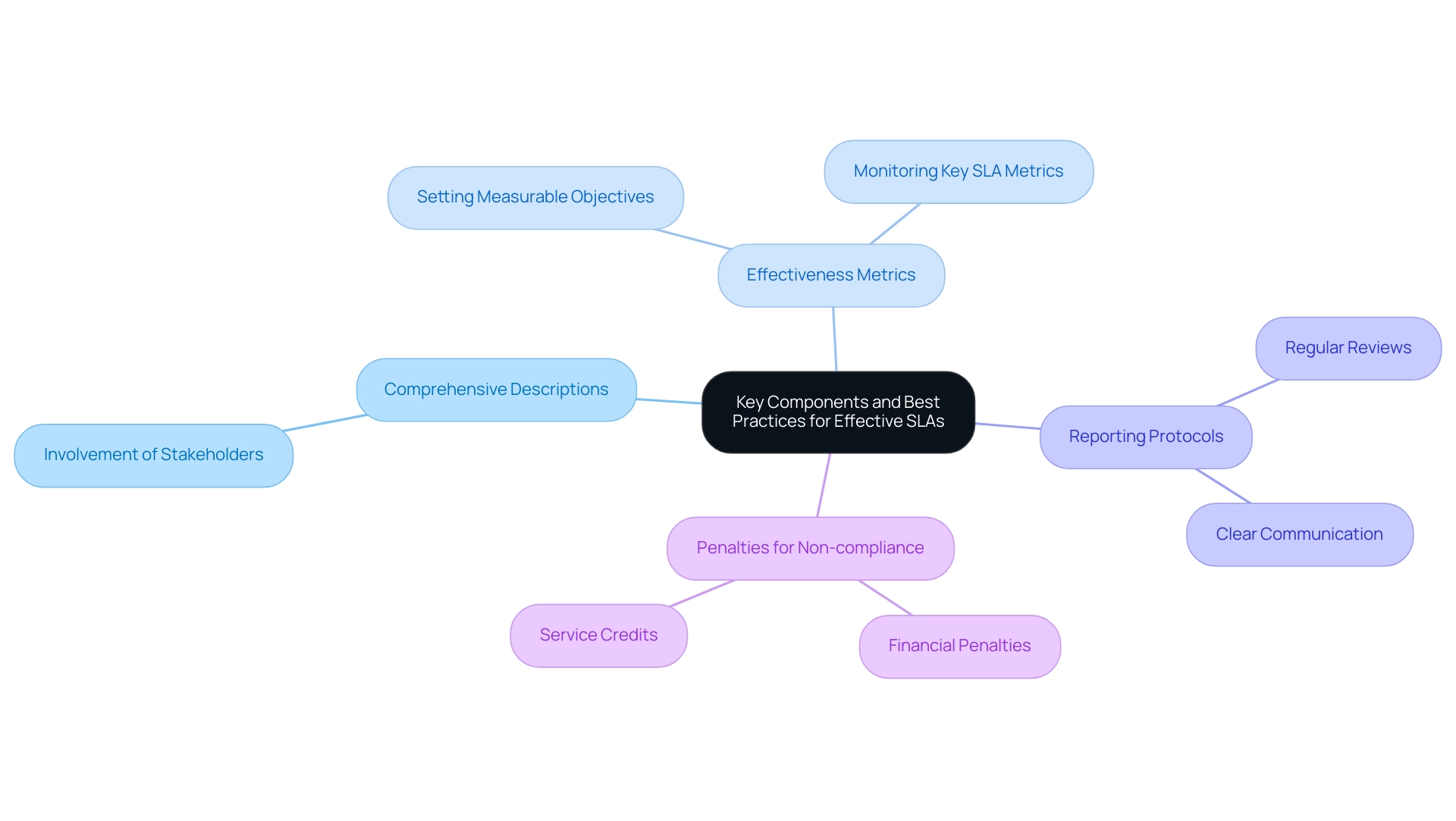
The Advantages of Implementing Service Level Agreements
Implementing Service Level Agreements offers a wealth of advantages of service level agreement that significantly enhance IT Service Management. One of the primary benefits is the improvement of service quality. Service level agreements provide a framework for measuring performance, enabling organizations to set clear expectations that clients can rely on.
Khalid Saad Al Medbel, a cybersecurity specialist, emphasizes that service level agreements are crucial for establishing trust; they articulate what clients can expect and hold providers accountable for delivering on those promises. This increased accountability promotes clearer communication between providers and clients, ensuring that both parties are aligned on the objectives of delivery. Furthermore, by establishing measurable objectives, such as the mean time to recovery, which measures the average time taken to recover a product during an outage or failure, SLAs empower organizations to track their performance effectively.
A recent study suggests that companies tracking SLA metrics can pinpoint areas for enhancement, ultimately resulting in improved delivery processes. The six key components of a data SLA include:
- Purpose
- Promise
- Measurement
- Ramification
- Requirements
- Signatures
These components collectively ensure a comprehensive understanding of expectations. Additionally, the case study titled 'Benefits of Monitoring SLA Metrics' highlights that real-time monitoring enables IT teams to detect system weaknesses and optimize service delivery, resulting in improved customer satisfaction rates.
This proactive approach not only drives continuous improvement but also correlates with increased customer satisfaction rates. As companies prioritize the advantages of service level agreements in 2024, they establish the foundation for a more dependable and responsive IT environment, enhancing customer loyalty and satisfaction.
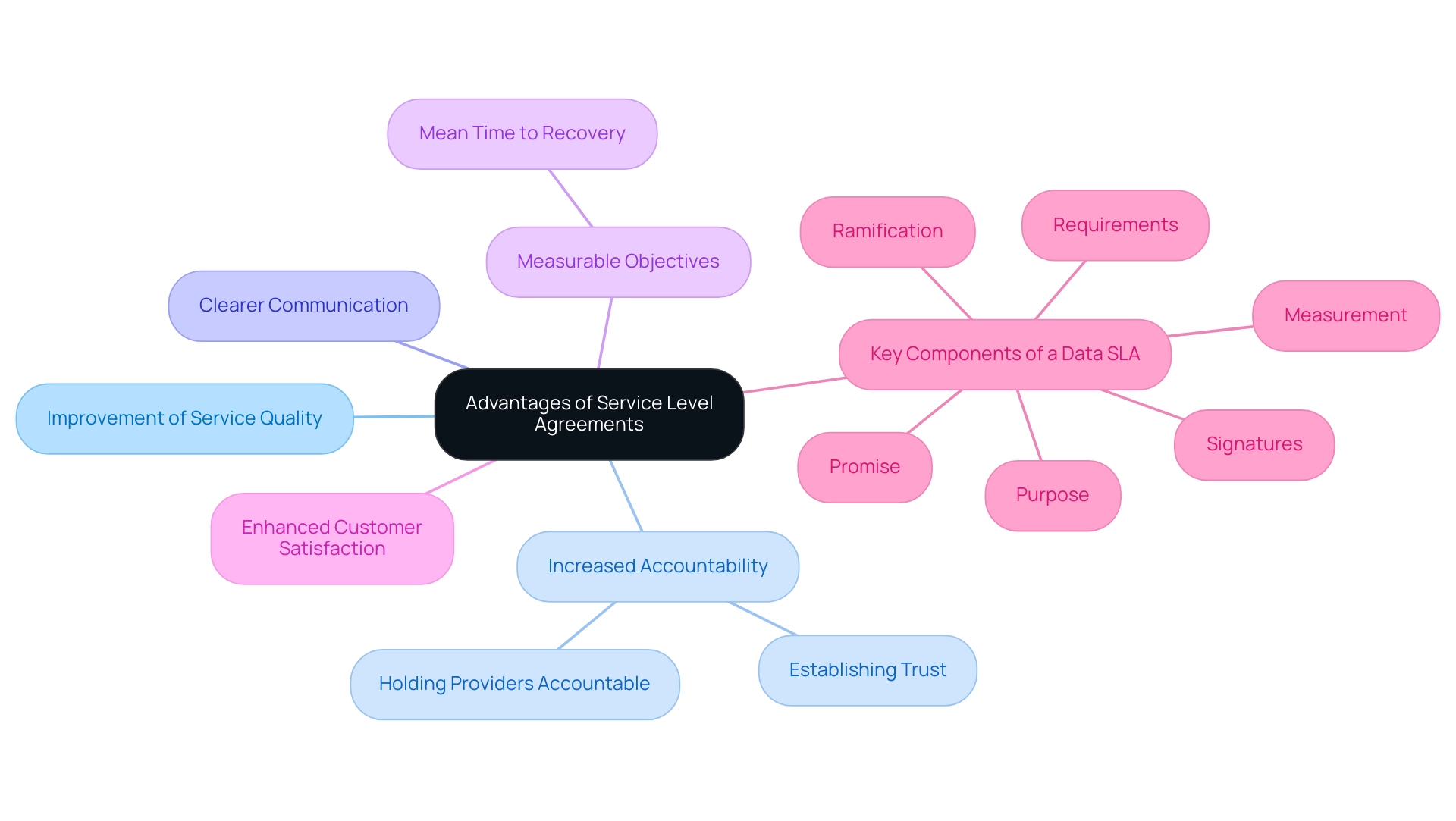
Challenges in Managing SLAs and How to Overcome Them
Managing Service Level Agreements presents several challenges, including:
- Misalignment of expectations
- Difficulties in measuring performance
- Communication breakdowns
These issues can obstruct efficient IT support management, as emphasized in the case study, 'The Importance of Service Level Agreements in Relationships.' This study reveals that the advantages of service level agreements are vital for establishing clear customer expectations and ensuring service teams comprehend their responsibilities.
To address these challenges, organizations must ensure that the advantages of service level agreements are realized by:
- Aligning them with overarching business goals
- Clearly defining achievable evaluation metrics
Regular communication with all stakeholders is crucial for maintaining this alignment and swiftly addressing any emerging issues. Furthermore, leveraging advanced technology tools, such as those offered by Go High Level, which combines CRM, marketing automation, and client communication tools, can greatly simplify performance measurement.
This approach enhances transparency and ensures that both parties remain well-informed and aligned, fostering stronger relationships. Notably, organizations that successfully navigate these challenges report an average of 9 out of 10 days saved through improved SLA management. Moreover, Chronosphere customers, on average, reduce their observability data volumes by 48% while decreasing troubleshooting time by 50%, exemplifying the advantages of service level agreement strategies.
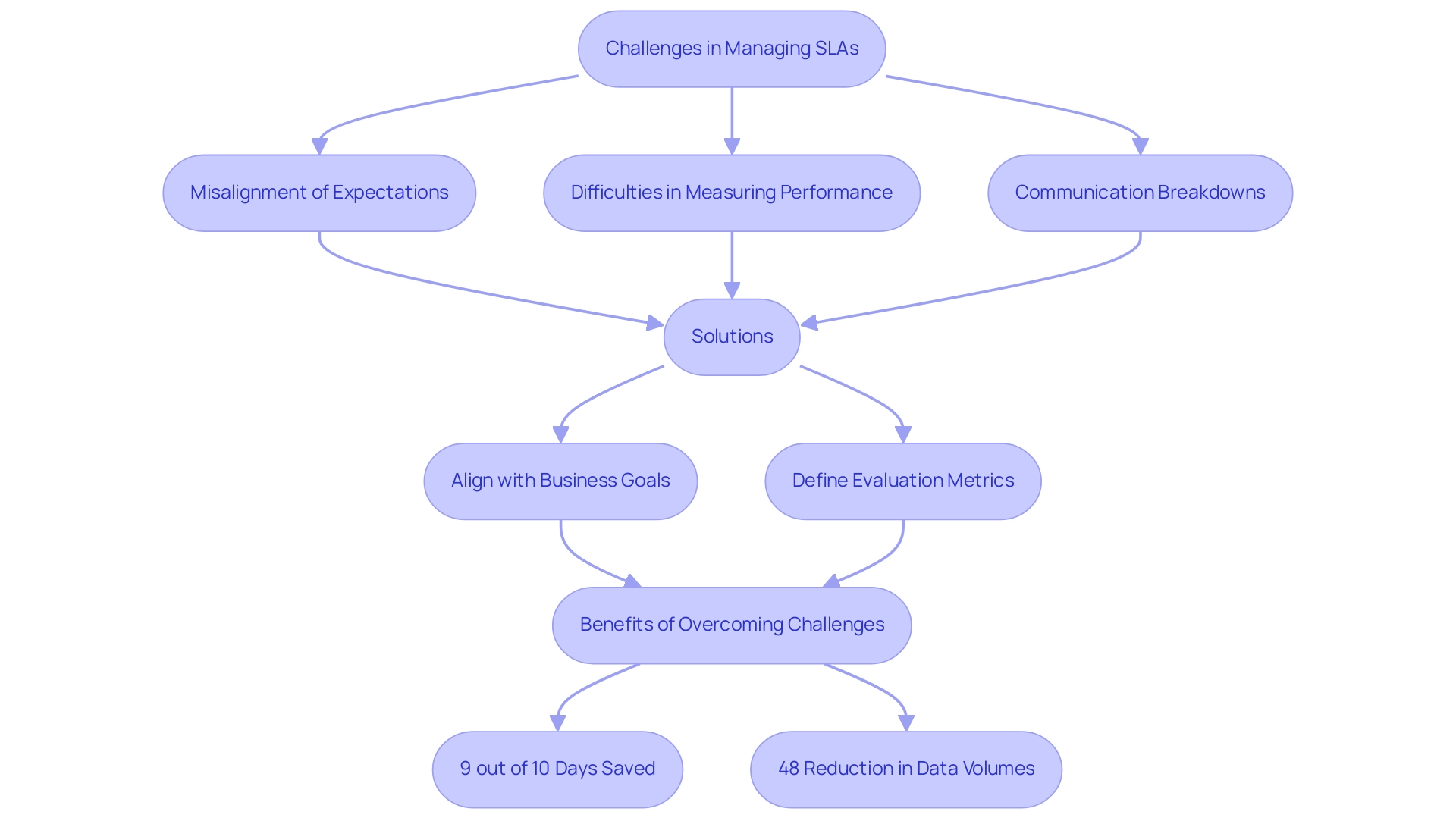
The Future of Service Level Agreements: Trends and Innovations
The trajectory of Service Level Agreements is increasingly influenced by pivotal trends, particularly the integration of automation and artificial intelligence in monitoring and enforcing compliance. As organizations strive for efficiency, the automation of SLA compliance monitoring is becoming commonplace, streamlining processes and enhancing accuracy. This illustrates a wider trend towards customization; for example, recent findings indicate that 64% of marketers personalize their communications by segmenting their audiences, a principle that highlights the advantages of service level agreements, where tailored contracts can lead to better alignment with client needs.
Furthermore, companies are gravitating towards more flexible service agreements, enabling swift adaptations to the dynamic landscapes of business and technology. This flexibility is essential as it allows organizations to remain agile and responsive to change. A significant change towards customer-centric agreements is also evident, showcasing the advantages of service level agreement with an increased emphasis on client satisfaction and customized delivery.
Zendesk exemplifies this trend by incorporating customer satisfaction scores into their SLAs, emphasizing the necessity of measuring quality from the client's perspective. Furthermore, a case study named 'Service Improvement through Help Desk Outsourcing' indicates that besides cost savings, many IT organizations report enhancements in customer experience after outsourcing their help desk, with 78% considering their experience to be better or the same compared to in-house operations. This highlights the significance of careful selection of outsourcing partners to ensure quality delivery.
As digital transformation accelerates, the advantages of service level agreements must evolve to include metrics that not only assess service delivery effectiveness but also reflect the quality of customer experiences. The necessity for regular reviews and updates of SLAs is paramount to ensure they remain relevant and effective in this rapidly changing environment.
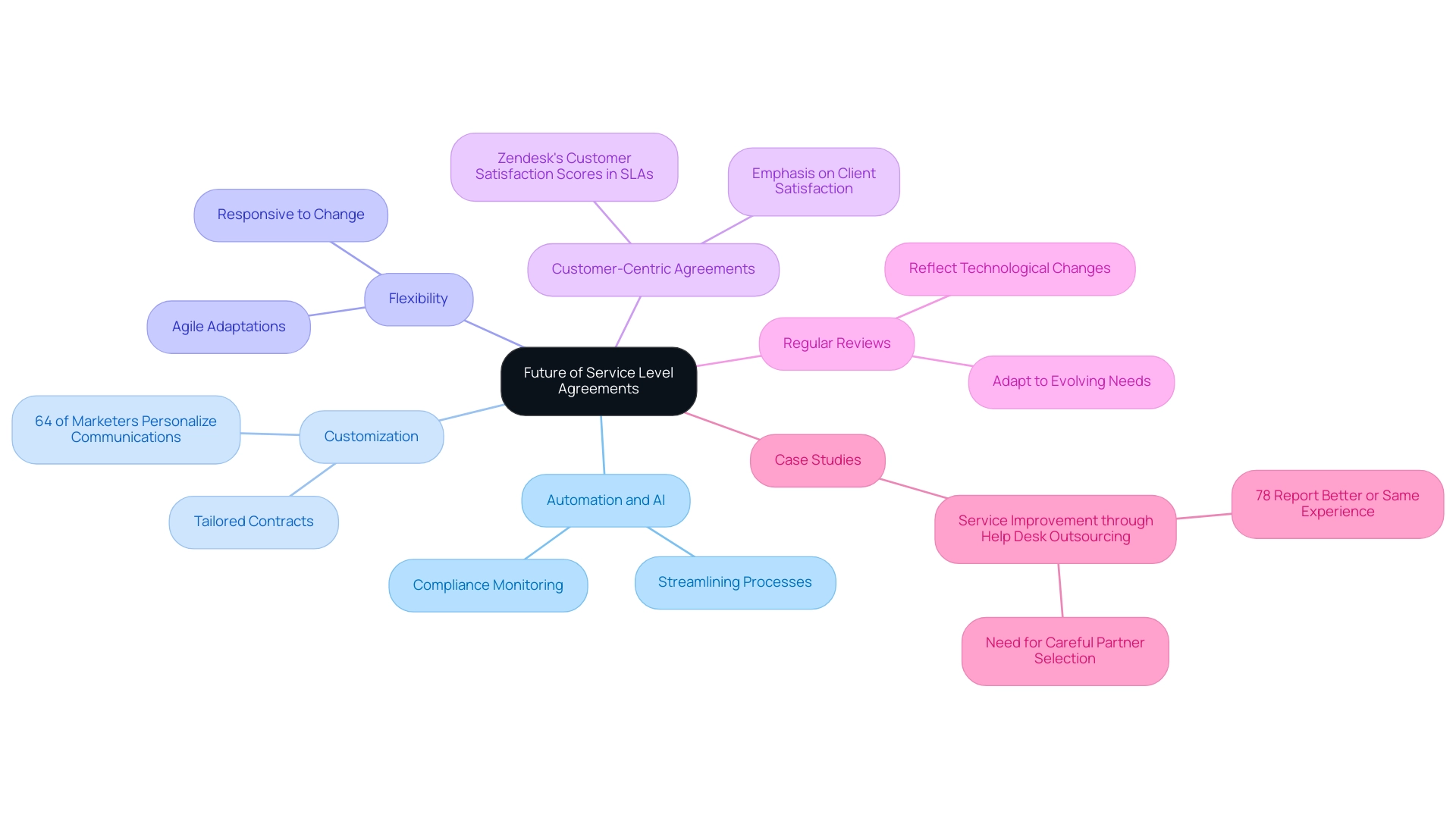
Conclusion
The exploration of Service Level Agreements (SLAs) reveals their essential role in establishing clear expectations and responsibilities between service providers and clients. By defining specific performance metrics and fostering a culture of accountability, SLAs significantly enhance service delivery and customer satisfaction. The article underscores the importance of crafting effective SLAs through collaboration, regular reviews, and transparent communication, all of which contribute to improved service quality and alignment with business objectives.
Implementing SLAs offers numerous advantages, including heightened accountability and the ability to track performance against measurable objectives. As organizations increasingly prioritize reliability, the proactive monitoring of SLA metrics becomes vital for identifying areas for improvement and optimizing service delivery processes. However, challenges such as misalignment of expectations and communication breakdowns must be addressed through strategic alignment with business goals and the leveraging of advanced technology tools.
Looking ahead, the future of SLAs is shaped by trends such as automation, customization, and a focus on customer-centric approaches. As businesses adapt to rapid technological changes, flexible and tailored SLAs will be crucial for meeting evolving client needs and ensuring high levels of service quality. Regular updates and revisions of SLAs will be necessary to maintain their relevance, ultimately driving stronger business relationships and improved service outcomes. In this dynamic landscape, effective SLA management not only mitigates risks but also lays the foundation for sustained success in IT service management.




